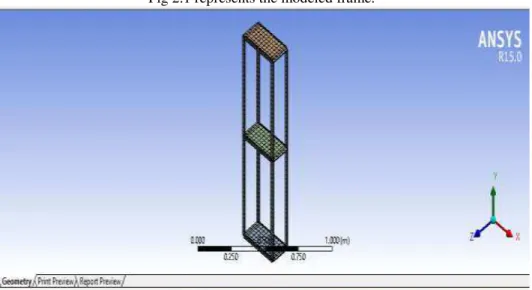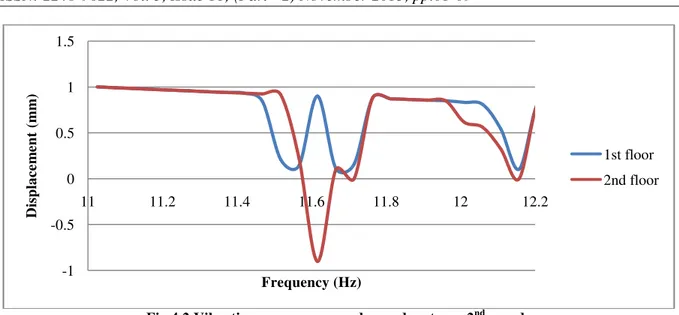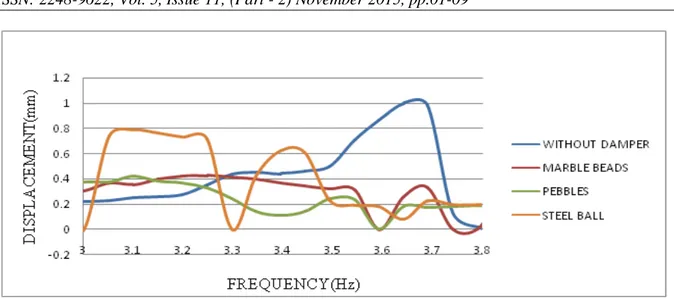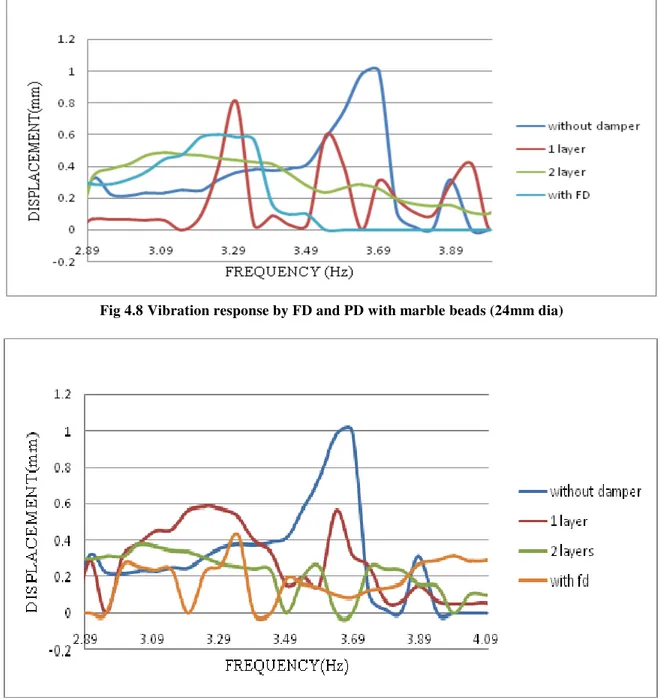Structural Vibration Control Using Solid Particle Damper
Haseena. A*, Ritzy. R**
*(M.Tech Scholar, Department of Civil Engg., Sree Buddha College of Engg., Kerala University, Alappuzha Dist., Kerala, India)
** (Assistant Professor, Department of Civil Engg., Sree Buddha College of Engg., Kerala University, Alappuzha Dist., Kerala, India)
Abstract
In this paper the effectiveness of a solid particle damper to control structural vibration is experimentally investigated. The vibration control performance and its influencing parameters are examined by a Multi Degree of Freedom (MDOF) structure attached with a particle damper (PD) under horizontal excitation. In a particle damping system damping is achieved using solid particles or granules and is a passive damping method. Here the enclosure filled with particles is attached to the primary structure undergoing vibration. As the primary structure vibrates, particles undergo inelastic collision within the enclosure resulting high amount of energy dissipation. Based on the analytical study of undamped frame in ANSYS WORKBENCH, dimensions of the frame were fixed and shake table study of a two storied steel frame with and without damper system are carried out. Results shows that effectiveness of damping depends on various parameters like mass, particle size, shape etc. The effectiveness is compared with a friction damper (FD) and is observed that PD is more efficient than FD since 31.80% energy is dissipated more in PD compared to FD
Keywords:
Particle dampers, Shake table study, Vibration control, Energy dissipation.I.
INTRODUCTION
Various dynamic forces like wind, earthquake etc may cause unwanted vibrations in structures. The presence of such vibrations may lead to damages and ultimate failure of the structure due to excessive inelastic deformations. Therefore structural vibration control is an important field of study in civil engineering from a long time now. Vibration can be controlled by improving damping performance of the structure. By adding damping to a structure, energy dissipation occurs from the system as a result amplitude of an oscillation reduced and vibration can be controlled. Particle dampers (PD) are efficient passive damping devices which are used to suppress the vibration of lightly damped structures.
Particle dampers are highly nonlinear dampers whose energy dissipation, or damping, is derived from a combination of energy loss mechanisms.
Particle dampers are enclosures in the form of boxes, cylinders or any other shapes partially filled with metallic or nonmetallic particles attached to the vibrating structure or primary system. As the primary system vibrates, particles within the enclosure undergo inelastic collision among particles and with container wall, as a result the kinetic energy of the system is dissipated as heat due to friction, impact etc in a highly nonlinear behavior. Particle dampers are
highly reliable, insensitive to extreme environmental conditions like high temperature, corrosive environment etc., less prone to damping property degradation due to age, high cycle fatigue and other permanent time effects. They are cheaper and maintenance cost is also very less and can be applied to different vibration suppression systems.
The objective of this paper is to study the effectiveness of particle damper (PD) in reducing the structural vibration of a multi-degree-of-freedom system and to study the influence of various parameters of different solid particles and their damping efficiency to reduce structural vibration. This paper will introduce a comparative experimental study of both friction damper and particle damper attaching to a two storied steel frame.
II.
ANALYTICAL MODEL
A two storied frame was modeled and analyzed using finite element analysis in ANSYS WORKBENCH 2015. From the modal analysis natural frequency and mode shapes were determined. For the finite element analysis, material used is structural steel having density 7850 kg/m3 and young’s modulus 2x1011
Pa. Beam and Shell elements were used to model the frame. The dimensions of the building frame model are represented in table 2.1. Table 2.1 Geometric properties of the model
Sl.No Parts Dimensions in mm
Depth (D) Width (B) Length (L)
1. Column 5 25 600
2. Slab 8 150 300
From modal analysis, dynamic properties such as natural frequency corresponding to each mode shape and time period were obtained. Block Lanczos Mode Extraction method is used to solve the problem. Modal analysis results are provided in table 2.2.
Table 2.2 Analysis Results
Mode Frequency(Hz) Period(s)
1 4.681 0.2136
2 12.524 0.0798
Fig 2.1 represents the modeled frame.
Fig 2.1 ANSYS Model of two storied frame
III.
EXPERIMENTAL SETUP AND
PROCEDURE
The experiments were performed using a two storied steel frame as a primary structure with three slabs and four rectangular columns. The storey height is 300mm. The dimensions of the test model are given in table 3.1.
Table 3.1 Dimensions of the test model Member Length x Width Thickness Column 25mmx5mm 5mm Slab 300mmx150mm 8mm
Particle damper is attached on the top floor of the steel frame and the entire assembly is placed on the Horizontal Shake Table. PD consists of an enclosure partially filled with particles. Enclosure is made of 4mm thick mild steel plates. The dimensions of the boxes are 210x80x200mm. Experiment is done under harmonic excitation with a limited operating frequency ranges from 0 to 25 Hz. Series of experiments were conducted with different types of particles in order to study the effect of various parameters. Various particles used for the experimental study are shown in Fig 3.1.
Displacement of each storey is captured with the help of accelerometers connected at first and second floor in both the two cases i.e. undamped and damped condition. Fig 3.2 represents the experimental setup of the two storied frame with Particle damper system.
Fig 3.2 Experimental setup with PD
IV.
RESULTS AND DISCUSSIONS
4.1 Seismic Response of an Undamped SystemThe seismic response of an undamped MDOF structure, when it is subjected to sinusoidal base
excitation is measured from shake table experiment. First and second modes are obtained from the experiment. Output is obtained as Frequency Vs displacement plot are shown in Fig 4.1 and 4.2.
Fig 4.1 Vibration response an undamped system - 1st mode -0.2
0 0.2 0.4 0.6 0.8 1 1.2
3 3.5 4 4.5 5
D
ispl
acem
ent
(
m
m
)
Frequency (Hz)
1st floor
Fig 4.2 Vibration response an undamped system - 2nd mode
Natural frequencies of undamped system are determined from finite element modal analysis and also measured from experiment. From the observations, there is an only slight variation of natural frequencies obtained from analytical and experimental study.
4.2 Seismic Response of Damped System (Frame with PD)
Experimental investigation is done to study the feasibility of PD considering the influence of various parameters.
4.2.1 Influence of size of particles on vibration response of frame with PD
To study the effect of size of particle on vibration response, series of shake table tests were performed with marble beads of varying diameters such as 24mm, 20mm and 16mm dia. The particles were packed into the steel container for same weight. The normalized plot for the test results are depicted in Fig 4.3.
Fig 4.3 seismic response of floor with marble beads of various diameter as PD
From the Fig 4.3 it is clear that for larger particles damping is less compared to smaller particles. It is because as diameter decreases there are more particles in the container and there would be more collisions between the particles and hence a greater dissipation of energy. Difference in area under the curves with and without damper represents energy dissipation.
4.2.2 Influence of particle materials on vibration response of frame with PD
Experiments were performed using metallic as well as non metallic materials such as steel balls, marble beads and pebbles. In each case the particle packing is constant but each material has different densities. Pebbles are the densest among different materials .The obtained experimental results are shown in Fig 4.4.
-1 -0.5 0 0.5 1 1.5
11 11.2 11.4 11.6 11.8 12 12.2
Dis
pla
ce
m
ent
(
m
m
)
Frequency (Hz)
1st floor
Fig 4.4 seismic response of floor with various materials as PD
Fig 4.4 shows that the densest material i.e. pebbles damp more than other particles since the remaining energy is less for pebbles. It is because as density increases the mass within the container increases is because as density increases and there would be more collision and greater surface friction resulting higher energy dissipation and greater damping.
4.2.3 Effect of irregularity of particles on vibration response of frame with PD
In this study, two types of irregular particles were tested to study its effect on damping. They are plastic particles of similar shape (cubical) and large solid particles (pebbles) with dissimilar shape. Mass of the particle is kept constant. The results are shown in Fig 4.5.
Fig
4.5 seismic response of floor with irregular materials as PD
From the results it can be seen that irregular particles have greater effect on damping performance. Here a pebble shows greater damping since they are more irregular than plastic particles. As irregularity increases more surfaces participates in the collision process as a result greater energy dissipation occurs.
4.2.4 Effect of number of layers on vibration response of frame with PD
Fig 4.6 seismic response of floor with marble beads of various layers as PD
As number of layers increases damping performance also improved. Here maximum damping is observed with two layers of particles compared to other. Maximum energy dissipated in marble beads with two layers because as number of layers increases more particles involved in collision process.
4.3 Seismic response of Frame with Friction damper (FD)
In order to investigate the effectiveness of PD, the vibration response of the frame with PD is to be compared with newly developed friction damper and
experimental study was conducted in 2 DOF structure with Friction damper. From the shake table study under horizontal excitation, vibration data were captured for each floor up to 4Hz.
The damper is based on rotational friction concept and is categorized under passive vibration control method. Friction damper is attached to bottom surface of top slab of the two storey frame by bolting. Here energy is dissipated due to sliding friction across the interface between axle and bearings. Experimental set up with FD is as shown in Fig 4.7.
Observations from the experimental study were plotted and the results were compared with Structural responses of PD obtained with marble beads of different diameters. The results are depicted in Fig 4.8, Fig 4.9 and Fig 4.10. From the results it is
evident that PD with marble beads is more effective than FD since obtained displacement is less with PD compared to FD. Also the energy dissipation is more with PD due to its inelastic collision and impact of particles.
Fig 4.8 Vibration response by FD and PD with marble beads (24mm dia)
Fig 4.10 Vibration response by FD and PD with marble beads (16mm dia)
4.4 Energy Dissipation between FD and PD Difference in area under the curves with and without damper represents energy dissipation. Fig 4.11 represents the energy dissipation values in FD
and PD. From the graphical representation it is clear that PD is more effective compared to FD since 31.80% energy is dissipated more in PD compared to FD.
Fig 4.11 Energy dissipation in FD and PD
V.
CONCLUSIONS
In this work the experimental investigation of PD with different materials are done. The performance of metallic as well as non metallic particle dampers used for controlling the vibrations of MDOF structures under seismic loads are studied and found that non metallic particles are also feasible. The effectiveness is studied by comparing the PD with a FD. Following conclusions are drawn from the study.
It is found that particle damper can effectively control the fundamental mode of the Multi
Degree of Freedom (MDOF) system. From shaking table study it is observed that damping using particles or granules is an effective passive damping method.
Effectiveness of the damping depends on various parameters like material property, mass, shape, no of layers, size etc.
For larger particles damping is less compared to smaller particles, since more collisions between the particles results greater dissipation of energy.
18.4 19.90252
30.249
41.33581
FD PD
ENERGY DISSIPATION
Irregular particles have greater effect on damping performance compared to spherical particles.
Maximum energy is dissipated in PD with marble beads compared to other particle materials.
No. of layers of particle is proportional to damping
Recycled Plastic particles also show some amount of damping. So plastic waste are used for these purposes.
It has been found that PD is more efficient than FD since 31.80% energy is dissipated more in PD compared to FD.
REFERENCES
[1] N. Popplewell, S.E. Semercigil (1989), “Performance of the bean bag impact damper for a sinusoidal external force”, Journal of Sound and Vibration, no: 133, pp. 193-223
[2] S. Ema, E. Marui (1994), “A fundamental study on impact dampers.” Int. J. Mach. Tools Manufactures, no: 34, pp. 407-421. [3] R.D. Friend and V.K. Kinra (2000),“Particle
impact damping”. Journal of Sound and Vibration, no:233, pp. 93-118.
[4] M. Saeki (2002), “Impact damping with granular materials in a horizontally vibrating system. Journal of Sound and Vibration, no:251, pp. 153-161”.
[5] M Trigui1, E Foltete, M S Abbe1, T Fakhfakh, N Bouhaddi, and M Haddar (2009), “An experimental study of a multi-particle impact damper” Journal of mechanical engineering science .
[6] X. Lu Z. Lu, S. F. Masri (2011), "Studies of the performance of particle dampers attached to a two-degrees-of-freedom system under random excitation", JVC/Journal of Vibration and Control. [7] Zheng Lu, Dianchao Wang, and Peizhen Li






